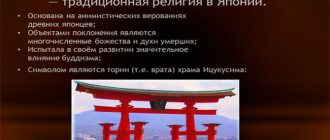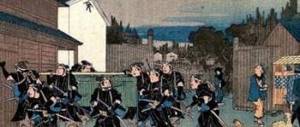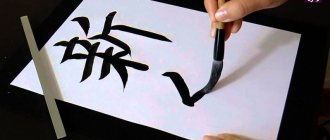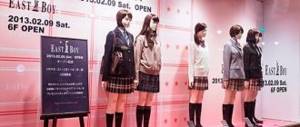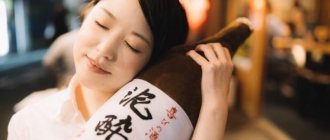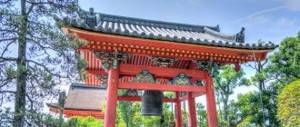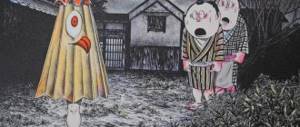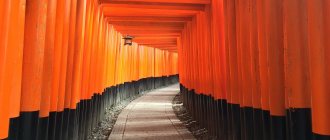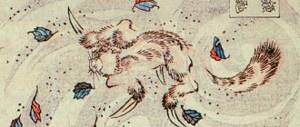Quote from Kapochka_Kapa's message
Read in full In your quotation book or community!
Traditional Japanese clothing.
The Japanese national costume has a long history.
The main attributes of traditional clothing are geta, kimono, hakama and netski.
In the Japanese language, kimono, and in the broad sense of the word means “clothing”, more precisely, national clothing, in contrast to European, which is called “yofuku”, is a collective concept; there are several varieties of them: firstly, for men and women, and secondly , upper ones (which, in turn, are divided into kimonos with long, up to one and a half meters, sleeves - furisode and with short ones - kosode) and lower ones, as well as home and sleeping ones - yukata.
In modern Japanese, there are three words for Japanese traditional clothing: 1. kimono (着物) - outfit 2. wafuku (和服) - Japanese clothing 3. gofuku (呉服) - “Chinese” clothing
The oldest of them is the first option. By the beginning of the Westernization of Japan in the mid-19th century, it was used to designate any clothing. Back in the 16th century, Portuguese Jesuit missionaries reported in reports to Europe that the Japanese called clothing the word kimono. This name has migrated to most foreign languages, including Russian. Although in pre-modern Japan "kimono" was an analogue of the universal concept of "clothing", in Europe and America it became associated specifically with Japanese attire. At the end of the 19th century in Japan, the number of people who began to wear Western-style clothing increased. The difference between Western and Japanese costume forced the Japanese to distinguish the latter from the general concept of “kimono”. A neologism arose to denote traditional clothing - “wafuku”. Until the end of World War II, this word became the main word for defining Japanese attire. However, in post-war times, under the influence of the American “understanding” of Japanese reality, the universal term “kimono” began to be used as one of the synonyms of “wafuku”.
Kimono
Accordingly, in modern Japanese, “kimono” has two meanings. In a broad sense, it is a general term for any clothing, and in a narrow sense, it is a type of wafuku. Archaeological finds in the Japanese archipelago support the thesis that the earliest Japanese wore simple hemp clothing at the end of the Jomon era. At the beginning of the 1st millennium BC. e., under the influence of continental fashion, a Korean-Manchu type suit came to Japan. The earliest kimonos, which appeared around the fifth century AD, were very similar to hanfu, traditional Chinese clothing. In the eighth century, Chinese fashion made the collar collar part of modern women's clothing. During the Heian era (794–1192), the kimono became highly stylized, although many still wore a mo train over it. During the Muromachi era (1392-1573), the kosode - kimono, previously considered underwear, began to be worn without hakama pants over it, so the kosode had an obi belt. During the Edo era (1603-1867), sleeves grew in length, becoming especially elongated for unmarried women. The obi became wider, and different ways of tying the belt appeared. Since that time, the shape of the kimono has remained almost unchanged. The revolution in Japanese clothing was brought about by the Westernization reforms of the Meiji period in the second half of the 19th century. European fashion began to supplant Japanese traditional costume. This process was gradual and superficial until 1945, affecting only the leading layers of society. However, the democratization and “Americanization” of the lifestyle of ordinary Japanese led to the fact that the Japanese kimono was forced out of everyday life. Today, Japanese traditional costume is used mainly only during holidays and formal events.
Features of kimono
The kimono resembles a T-shaped robe. Its length may vary. Clothing is secured to the body with an obi (帯) belt, which is located at the waist. Instead of European buttons, straps and twine are used. A characteristic feature of the kimono is the sode (袖) sleeves, which are usually much wider than the thickness of the arm. They have a bag-like shape. The sleeve opening is always less than the height of the sleeve itself. Because Japanese traditional attire is robe-like, it does not have an open collar like European suits. In general, it is comfortable and does not hinder human movements. The fabrics from which kimonos are made are generally inelastic. Cloth is used for the belt. Patterns for clothing are usually rectangular and differ from their European counterparts in their complex rounded shapes. Thanks to this, savings and almost complete recycling of matter are achieved. Its rectangular remains can be reused on the farm. For sewing kimonos, predominantly soft threads are used, which reduce the risk of fabric tugging. However, such careful treatment of material, which was scarce in traditional Japan, negatively affects the preservation of the design of the clothing. If it is damaged, the kimono can be remade from the same fabric.
Kimono and Japanese aesthetics
Unlike traditional European clothing, which emphasizes the structure of the human body, a kimono highlights only the shoulders and waist of the wearer, hiding the flaws of his figure.
Western clothing emphasizes relief, while Japanese clothing emphasizes uniformity and flatness. This is due to the traditional Japanese idea of an ideal constitution - “the fewer bulges and irregularities, the more beautiful.” For example, in Europe, women's corsets were used to narrow the waist, and to look beautiful in a kimono, the “ideal figure” was not enough. The “ideal face” and makeup were considered an integral part of the ambiance. In the late Middle Ages, the standard of the “Japanese beauty” was established. The face should have been flat, and its oval should have been elongated. Slanted eyes with narrow and high eyebrows were considered beautiful. The mouth was supposed to be small and resemble a small red flower. Only the nose protruded relatively strongly from the low-profile face. A woman’s skin had to be as white as snow, which is why Japanese women have long whitened their faces and other body parts protruding from under the kimono. This ideal of a beauty is successfully depicted in Japanese prints of the 17th-19th centuries. Production
Men's kimonos come in different sizes, while women's kimonos are generally the same size and are adjusted using pleats. An ideal kimono has sleeves that end at the wrist. A man's kimono should fall to the elbow without forming folds. Women's kimono are longer to allow for ohashori, a special fold that peeks out from under the obi. Very tall or overweight people, such as sumo wrestlers, order a kimono for themselves, although there is usually a whole piece of fabric left in the finished product, with which it can be easily altered to almost any figure. A kimono is made from a single piece of fabric. A piece of fabric is usually about forty centimeters wide and eleven and a half meters long. This is enough to sew one kimono for an adult. The finished kimono contains four strips of fabric: two of them cover the body, and the remaining ones are used to form sleeves; in addition, additional strips are used for the collar, etc. In the past, kimonos were often ripped open before washing and sewn by hand afterwards. The traditional kimono is made by hand, and the fabric is also often made and painted by hand. Repeating patterns are applied in this case using a stencil. Over the years, many trends have changed in the style of kimono, accessories, type and color of fabric. Kimonos and obi are traditionally made from silk, crepe silk, satin; modern kimonos are made from cheaper and more practical material, crepe satin, cotton, polyester and other synthetic threads. Silk is still considered the ideal material needed in formal settings. Typically, woven patterns or small designs are worn in informal situations; in kimonos for formal situations, the designer's design runs along the hem or across the entire surface. In the Heian era, up to ten contrasting layers of clothing were worn under a kimono, and each color combination was strictly defined. Today, under a kimono, they most often wear another, thin one. By the pattern you can determine the season it is worn, for example, a pattern with butterflies or cherry blossoms will be worn in the spring, water patterns are common for summer, Japanese maple leaves are a popular autumn motif, and colors with pine trees and bamboo are suitable for winter. Old kimonos are recycled in many ways, they are used to make haori and kimonos for children, they repair similar kimonos, and they are used to make bags or accessories. A kimono with a damaged bottom is worn under the hakama to hide the bottom. Experienced textile workers used to remove threads from kimonos and reuse them into fabrics.
In principle, they are all a straight-cut robe with wide sleeves, wrapped around the chest on the right side, for both men and women. The left side of the kimono is wrapped only on the deceased before burial. Men secure the kimono with a belt at the hips, tying a knot on the right or back. Women's belts - obi - are located at the waist and above it and are tied with a wide, fluffy bow at the back. At first, the townspeople were forbidden to wear clothes made from expensive fabrics of bright colors, but, smart and resourceful, they learned to deftly circumvent these prohibitions. An inconspicuous and even shabby kimono made of simple fabric could have a luxurious brocade lining. The rich artisan wore several other, expensive and beautiful ones under a modest outer dress. At the same time, this ban gave impetus to the emergence and development of specifically Japanese aesthetics. They began to find beauty and charm in the simple and discreet. A good kimono is very expensive. The material for it is usually woven and painted by hand. In this case, a gimp made of silver and gold is used, and when dyeing, a powder of gold and silver powders is used.
Only a master can sew a ceremonial kimono: it is necessary to select pieces of fabric so that the pattern organically flows from the back to the chest and sleeves and creates the impression that this is not just clothing, but something more - a complete work of art. Precious ancient examples of kimono take pride of place in museums and are carefully kept in families, passed down from generation to generation.
Only very rich people, as well as actors of traditional Noh and Kabuki theaters, for whom the kimono is a stage costume, are paid a state subsidy for its purchase.
Dress kimonos are made from standard pieces of fabric, so they are all approximately the same size. A Japanese woman can wear a kimono purchased in childhood for the rest of her life and then pass it on to her daughter or granddaughter. The length is adjusted by picking up the excess under the belt, and then releasing it as the owner grows.
Homemade kimonos - yukata - are sewn with approximate height taken into account.
An important detail of a traditional outfit is the obi belt. It gives the kimono completeness and massiveness. As a rule, a special piece of brocade or thick silk, four meters long, is woven for the belt, with a particularly rich pattern at the front, where the belt fits tightly to the figure, and at the back, where it is tied with an intricate knot. There are several ways to tie a belt. In earlier times, the shape of the knot indicated the class of a Japanese woman, but now it depends only on her taste and skill. The length of the kimono varies depending on the situation. There are different sizes for men, but one universal size for women. It is adjusted to the figure by forming additional folds. Fastened at the waist with an obi belt.
A special feature of the kimono is its very wide sleeves - sode . The length of the sleeves of a Japanese kimono depends on their marital status; unmarried women have longer sleeves. The girls' outfit is much more lavishly decorated than a similar outfit for a married woman. Silk is considered ideal for a kimono, but cheaper materials such as crepe-satin, cotton, polyester, and crepe-silk are also used.
The ornament and design of the outfit depends on the time of year, the event and the status of the person. On a classic kimono, the design on silk is applied by hand. From the middle of the 19th century it received the status of “national costume”. Today it is used mainly during holidays, festivals and official events.
The decor of a kimono is always associated with the seasons and reflects the poetry and symbolism of natural phenomena.
Most often, the national costume is worn in connection with festive and special events. Elegant, bright kimonos with fur trim at the collar can be seen on modern girls on New Year's Day. The same beautiful kimono, but without fur, is worn by many to the official ceremony on Coming of Age Day, which is celebrated in January by 20-year-old Japanese.
The process of putting on a real kimono is a kind of creative act that reveals not a person’s figure, but the features of his character. The kimono wraps tightly around the body, instilling patience and submissiveness. Long hemlines, wide sleeves and a tightly tightened belt change a person’s movements, making them leisurely and soft, like a cat’s.
Wearing a kimono is a special science. The back is straight, the chin is slightly tucked in, and the shoulders are relaxed. Movements should not be sweeping or abrupt.
playlist
Under no circumstances, even by accident, should you show legs or other parts of the body hidden under clothing. This is not appropriate. The wisdom of this rule lies in the fact that it equalizes young and old women, hiding the faded beauty of the latter and the attractiveness of the former.
The Japanese believe that a woman acquires a different beauty over the years, and the kimono becomes a wonderful shell for this chest of spirituality.
According to tradition, the art of dressing a kimono is passed down from mother to daughter, but in modern Japan, specialized kimono schools are engaged in preserving this ancient tradition, which provide various courses for mastering the difficult science of dressing a kimono.
Yukata
Summer light cotton kimono with a printed pattern. Yukata is worn by both women and men. This is the simplest of all kimonos.
Furisode
— a girl’s festive kimono. Previously, furisode could only be worn by a virgin or a girl under 20 years old, after which it was necessary to change the type of kimono. In modern society, furisode is the clothing of unmarried girls, regardless of age.
Ushikake
- wedding cape
Today's ushikake ( uchikake, uchikake ) is a luxurious long cape worn over a kimono, trimmed along the bottom with a roll of scarlet (less often gold) fabric to glide more gracefully across the floor. Currently, the term "ushikake" is only used for the bride's outer kimono. Before the Edo era, ushikake was worn as casual and formal wear (depending on the decoration and material) by nobles and women from samurai families. At the end of the 19th century, ushikake also began to be called the outer kimono worn at the wedding ceremony. Ushikake is made of brocade or silk, lined with cotton wool, has long sleeves (more than 1 meter), is not tied with a belt, is not tucked, using the entire length of the dress.
Kimono TchiTchi & Martin Wedding
Ushikake wedding cape
with peacocks on a pine tree.
In ancient times, a kimono could be tied with a belt, picked up, and several ushikake could be worn at once. There were also male varieties of ushikake, not inferior to female ones in the splendor and brightness of their decor. Such costumes were worn by courtiers or at receptions in the imperial palace until 1870.
Tomesode - married woman's kimono
A strict short-sleeved kimono, usually black, with a wide patterned stripe along the hem and five family coats of arms. It is worn at family formal celebrations. Colored tomesode
called “iro-tomesode”, it is less strict and solemn
Other clothing accessories
Japanese women do not wear hats. A beautiful high hairstyle or a chic head of hair is considered a decoration. Hakama are long trousers. First appearing in the 6th century, they were originally a piece of cloth wrapped around the hips. Over time, they transformed into long pants with pleats, similar to a skirt. Worn by men in informal settings or as a uniform in some martial arts. Netsuke (netsuke) is a detail of the Japanese national costume, it is a carved keychain. The kimono has no pockets; containers for carrying keys and a pouch were attached to the belt using a hanging netsuke keychain. At the same time, it served as a decoration for the outfit. A wide variety of materials are used to make netski: wood, ivory and walrus ivory, deer and buffalo antlers, bear, wolf and tiger fangs. Geta are traditional wooden sandals worn by men and women. Susoyoke is an underskirt worn under a kimono.
Haori-himo is a woven strap used to tie a haori. It is usually white in color. Nagajuban - is a lower kimono, it is shorter than the upper one and is used as underwear. A special thin shirt is worn under it - Hadajuban, which separated the expensive silk fabric from the body. The sleeves of the lower kimono are longer than those of the upper one, and the cuffs are made of more expensive material. The collars were made interchangeable. Hakama are pleated wide pants used in certain types of martial arts. Haori is an outer covering usually worn by men and extending to the hips. For women, the haori is usually longer. Hiyoku is an underwear kimono worn at weddings and other social events. Junihitoe is a complex kimono consisting of 12 layers. It was usually worn by court ladies. Now such clothes can only be seen at an imperial wedding or enthronement ceremony. Kanzashi - a variety of jewelry designed for traditional hairstyles. These could be silk flowers, wooden combs or jade pins.
Geta
Geta is the national shoe of Japan. Wooden sandals shaped like a bench on two legs. The height varies depending on the purpose, reaching 10-15 cm. Gete are secured to the leg with two laces. Women's ones are decorated with bells, beads, brocade, and sequins. The value of men's shoes is determined by the type of wood used for manufacturing and the fineness of the carving applied.
In general, national Japanese shoes are not very comfortable. For example, “geta”, wooden sandals with two high heels. In geta, it’s good to walk through puddles, waddling from heel to heel and with these movements reminiscent of a heron, but you won’t be able to chase a departing bus in them. But “geta”, like “zori”, is very easy to throw off when coming into the house. In short, its national footwear has not found distribution anywhere outside of Japan.
A century ago, geta were usually made of wood. But, despite the seemingly banality of its forms, geta had many features. And today they can indicate the social status or occupation of the owner. Thus, an observant eye can notice the difference between the very strictly quadrangular geta (kaku geta), which is usually worn by middle-aged men, and the geta with rounded corners, used by elderly men or clergy. Some can even recognize the nomeri geta (forward bending gag) that are popular among performers.
It goes without saying that, depending on belonging to different classes and seasons, the getas had different decorations. Thus, men's geta were partly inferior to women's in aesthetics, but they attached significant importance to the type of wood used, skillful carving and varnishing applied to the surface. Women's ceremonial dresses were covered with gilded brocade and looked more like slates, although in winter, especially in snowy areas, they were made higher than usual. Moreover, female geta specifically indicate the age of their owner. True, now with business clothes most women choose to wear soft sandals made of fabric with an insole - zori.
Zori - sandals without heels, but with a thickening at the heel. Favorite shoes for everyday life and an indispensable attribute of the national holiday costume. The zori are held on their feet by straps that pass between the big and second toes. Unlike geta, they are made separately for the right and left legs. They are made of leather, straw, synthetic materials (including vinyl, which makes the shoes even softer and more comfortable). And although it is not so common to hear the shuffling sounds of the famous geta in today's Japanese metropolis, they remain to this day an undoubted attribute of traditional Japanese clothing, which was still used during the coming of age ceremony (after reaching the age of 20), marriage , as well as geishas and other representatives of the art world who dress in kimonos.
Obi(belt)
Obi
(Japanese 帯?, lit. "belt") - several different types of Japanese belts worn by both men and women over the kimono and keikogi.
Male
obi, as well as obi for martial arts, is relatively simple and narrow, no more than 10 centimeters in width, and is tied with a simple knot.
Female
The obi reaches 30 centimeters in width and 4 meters in length, is tied with an elaborate large decorative bow at the back, and usually costs more than the kimono itself. There are complex rules of etiquette about which obi can be worn in which situations, and with what bow they should be tied.
Kimono
The kimono is considered traditional Japanese clothing, which since the 18th century has also been considered the national costume of Japan. Kimono is available for men and women. This is a T-shaped robe that can have different lengths. The robe does not have fasteners or buttons, but is fastened with an obi belt, which is located at the waist. European buttons in the Japanese kimono are replaced by straps or strings. This type of Japanese clothing has sobe sleeves, which are wide.
Traditional women's shoes
The Japanese costume includes very specific shoes, which may seem uncomfortable to residents of European countries. Among the most popular national models are geta and zori. The features of each of them should be considered in detail.
Dzori were intended for peasant women. Naturally, the shoes were very simple and far from the most attractive. It was an oversized woven sandal equipped with a sole.
Only rich women and geishas could wear geta. These national shoes come in two varieties. In the first case, it is equipped with a massive wooden block, in the lower part of which there is a recess. In the second it is a kind of bench. It is also made of wood. The platform could be a maximum of ten centimeters in height. To keep the shoes securely on the foot, laces were used. They were secured between the thumb and index finger.
The most talented artists were involved in the production of geta. They decorated shoes with extraordinary paintings. Many of these national products are now in museums. This is due to their incredibly attractive appearance. Art connoisseurs often call them a strong rival even to famous paintings.
Samurai clothing
Instead of pants, samurai wore trousers - nagabakama, which were wide and long, which did not restrict movement and ensured a lightning-fast reaction in the event of an attempt on the life of the ruler. After all, samurai in Japan were considered bodyguard warriors who served their masters. Samurai dressed differently than ordinary people in Japan. He wore a pair of swords in a wide belt, and his clothes had a special cut (reifuku). Everyday he wore wide hakama pants, a kimono with short sleeves (kosode) and an outer kimono. On top was a haori - a cape with short sleeves. It was forbidden for ordinary Japanese to wear samurai clothes. For violating this rule one could lose one's head. The samurai's clothes were sewn with family crests in five places. Only rulers and samurai had coats of arms. Coats of arms were not sewn on hakama, since such clothes could be worn by ordinary Japanese - artisans and traders.
Japanese warriors wore armor in the form of all-metal breast plates, which essentially played the role of a modern body armor. And his head was covered by a metal helmet. With the improvement of steel processing technologies, the armor of the Japanese warrior also changed. The Heian and Kamakura eras became the peak in the creation of weapons and the period of the birth of the samurai. Since then, little has changed and has survived to this day.
The samurai wore his armor only before battle or on special occasions. They took great care of their weapons and armor. Swords had their own names and were passed down as the greatest family value from generation to generation.
Modern street fashion
Japanese street style is a popular trend in modern Japan, which is inherited by young girls and boys all over the world. The term Japanese style combines several directions. They are all similar and interconnected, but have a number of differences. An uninitiated person will not immediately notice the difference:
- Harajuku – the Harajuku style is considered one of the craziest, originating in the Tokyo district of the same name. Life has always raged in this territory. The direction includes a combination of national style and modern fashion elements. It is characterized by many bright accessories and decorative elements;
- Lolita is the most common style that has gained wide popularity in the West. It contains a certain cult of infantility with an emphasis on the Gothic. Here you can find corsets, frills, lace, petticoats, ribbons. The “Lolita” direction is intended to emphasize the doll-like, childish image;
- Ganguro - the style is distinguished by bleached hair, an unusual dark tan and contrasting eye makeup in black and white. This style features long eyelash extensions and bright accessories. Miniskirts, high heels - everything together makes Japanese girls look like living dolls;
- Cosplay is a role-playing outfit that imitates your favorite animated and computer characters;
- Decora – decorating an image with numerous elements. Girls wear a lot of metal jewelry, pendants, bracelets, rings, and chains. The style is also complemented by sound attributes - bells, bells;
- Ko Gal - Teenagers love to wear school uniforms. They also dye their hair blonde and apply self-tanner to their body;
- Kawaii is a kind of touching infantile style. Its adherents prefer costumes of animals or cartoon toys. The predominant colors are blue, white, pink and beige;
- Visual Key - inspired by the youth subculture that is a fan of the Japanese punk and glam rock genre. Girls prefer clothes of incompatible shades, high-heeled or platform shoes, and dyeing their hair in bright colors.
The fashionable variability of modern Japanese designers distinguishes their collections with a standard set of items interspersed with national motifs and loose-fitting elements:
- outerwear is distinguished by its straight shape, loose fit, and slightly hugging the silhouette. The clothes carefully hide the female figure and its features;
- products made from thin translucent materials, which are complemented by huge bows;
- the use of lush gathers and folds to imitate a kimono;
- the presence of pointed elements, smooth transitions, bright shiny inserts, decoration with tassels.
Japanese teenagers love high waists, multi-layered outfits, and shapelessness. The reason for this was the opinion that in oversized things a small Japanese woman looks very touching and especially fragile. Modern variations of kimonos with robes silhouettes remain relevant. Sportswear of various designs is also in fashion. Japanese designers are actively working in this direction.
visual kei
Ganguro
Decora
Kawaii
Ko Gal
Cosplay
Lolita
Harajuku
Clothes of ordinary people
Ordinary people in Japan wore open or wrap-around robes, skirts - hakama or futano skirts were worn by men, and women wore koshimaki skirts. The underwear consisted of robes called juban. Outerwear was considered a kimono, which was sewn from straight pieces of fabric and also had a collar and cuff. To sew a kimono you need approximately 9 meters of fabric. On top of the kimono you could wear a cape - haori. Men also wore a skirt - hakama. If you look closely, women's and men's Japanese clothing have similarities.
A man in Japan wore a lower loincloth - fundoshi, as well as an undershirt - kosode. Then she put on a koshimaki skirt and juban. All underwear was made of cotton. Outerwear was kosode (prototype of kimono), kimono or haori. Kosode is a long robe with narrow sleeves and a stand-up collar. A kimono is a wraparound robe with wide sleeves on a belt.
School uniform
The Japanese school uniform deserves special attention. There are no strict rules in junior school. Children are simply not forced to wear a certain outfit. You only need to adhere to the traditional rules that the official style implies. During this period, little Japanese women wear light blouses and long sweaters that reach the knee. Boys wear white shirts and shorts made in blue or black.
Things are completely different in high school. During this period, the Japanese form underwent significant changes. Guys have to wear wardrobe items in a military stylistic direction. For girls, sailor suits are provided, which even European students can wear. This form is called gakuran. Translated from Japanese, it means a schoolboy from Europe.
Sailor suit is a Japanese suit made of a pleated skirt and jacket. The top is decorated with a collar made in a marine style. There is a loop on the blouse for a red ribbon. If desired, you can use bows, butterflies and ties instead.
Traditional Japanese clothing is multifaceted and extraordinary. She attracts special attention and simply cannot go unnoticed. It hides a certain mystery, fabulousness and even magic. It is not surprising that the Japanese costume remains in demand even now. Moreover, not only residents of Japan, but also many famous fashion designers show interest in Japanese clothing.
Clothing of feudal lords in Japan
The first picture shows Sokutai's clothing - a ceremonial dress that a nobleman wore to a reception with the ruler. Women's formal dress is shown in Figures 2 and 6. Men's home suit is shown in Figure 3, and women's home attire can be seen in Figures 4 and 5.
Varieties
It is very difficult to choose a vestment that will correctly correspond to the occasion, status, age, marital status, and traditions. After all, there are many varieties of this national clothing, especially for women. Main types of kimono:
- Homongi is an outfit for formal events and high-style receptions. The shoulders and sleeves are decorated with designs. Both married and unmarried ladies can wear it.
- Iromuji is a plain robe for the tea ceremony. The fabric may have a woven jacquard "rinzu" pattern.
- Tomesode is the most formal outfit for a married woman with a pattern below the waist or along the hem. Its variety is kurotomesode, black in color with five kamon coats of arms (family coat of arms), worn at the wedding by the mother of the bride and groom.
- Furisode is an official kimono for an unmarried girl with a sleeve train length of up to 1 meter. It can be seen on bridesmaids during a Japanese wedding or on maiko - apprentice geishas.
- Komon is an outfit with a small pattern. Suitable for walking, visiting a restaurant.
- Edo komon - polka dot kimono. Previously, it was worn mainly by samurai. Now, if coats of arms are applied to it, it can be used as clothing for receptions.
- Mofuku is a black mourning outfit intended for close relatives of the deceased. Others present at the ceremony may wear iromuji with black elements.
- Susohiki is a kimono with a long train, worn by geisha and performed in traditional dances.
- Yukata is a summer version of the national outfit made of linen or cotton. Is unofficial.
Iromuji
Mofuku
Susohiki
Tomesode
Furisode
Homongi
Yukata
